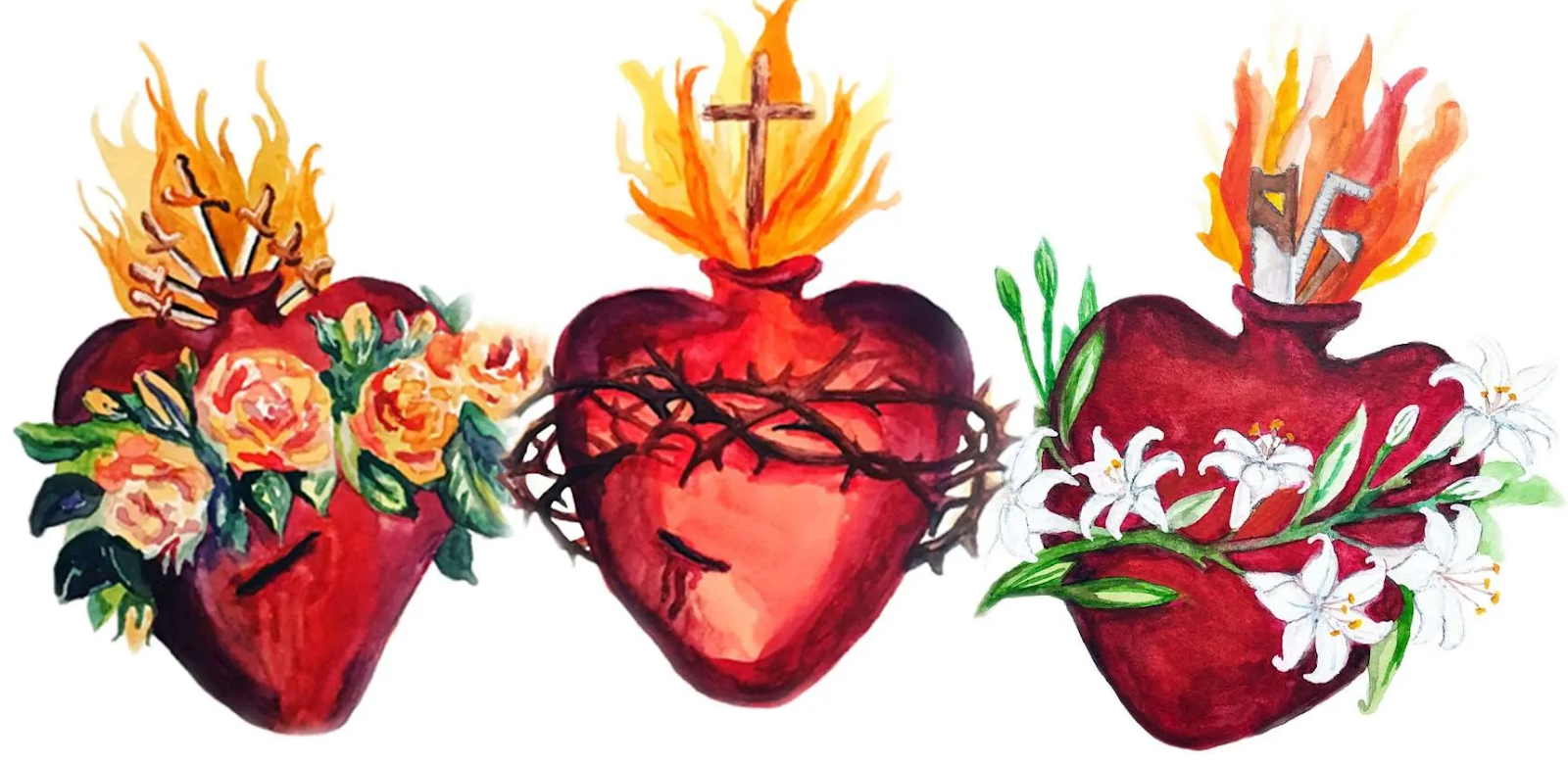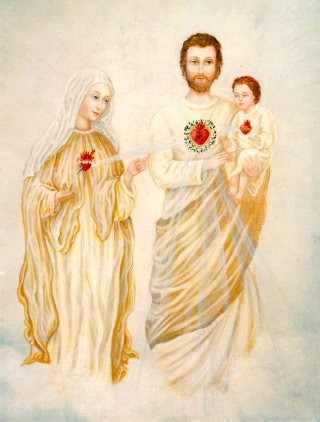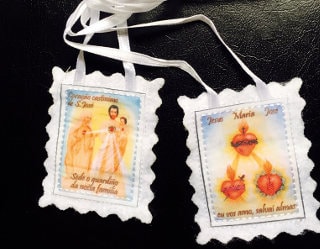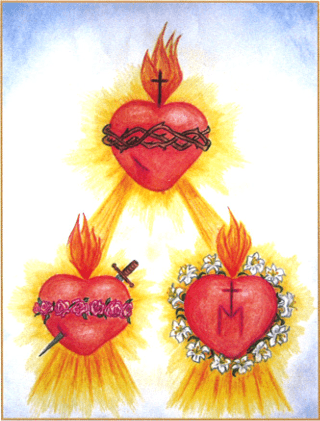
The image of Our Lady of Perpetual Help is an icon, painted on wood, and seems to have originated around the thirteenth century. Traditionally, the image is also known as “Our Lady of Perpetual Succour.” The icon (about 54 x 41.5 centimeters) depicts our Blessed Mother Mary, under the title “Mother of God,” holding the Child Jesus. The Archangels Michael and Gabriel, hovering in the upper corners, hold the instruments of the Passion– St. Michael (in the left corner) holds the spear, the wine-soaked sponge, and the crown of thorns, and St. Gabriel (in the right corner) holds the cross and the nails. The intent of the artist was to portray the Child Jesus contemplating the vision of His future Passion. The anguish He feels is shown by the loss of one of His sandals. Nevertheless, the icon also conveys the triumph of Christ over sin and death, symbolized by the golden background (a sign of the glory of the resurrection) and the manner in which the angels hold the instruments, i.e. like trophies gathered up from Calvary on Easter morning.
In a very beautiful way, the Child Jesus
The image of Our Lady of Perpetual Help is an icon, painted on wood, and seems to have originated around the thirteenth century. Traditionally, the image is also known as “Our Lady of Perpetual Succour.” The icon (about 54 x 41.5 centimeters) depicts our Blessed Mother Mary, under the title “Mother of God,” holding the Child Jesus. The Archangels Michael and Gabriel, hovering in the upper corners, hold the instruments of the Passion– St. Michael (in the left corner) holds the spear, the wine-soaked sponge, and the crown of thorns, and St. Gabriel (in the right corner) holds the cross and the nails. The intent of the artist was to portray the Child Jesus contemplating the vision of His future Passion. The anguish He feels is shown by the loss of one of His sandals. Nevertheless, the icon also conveys the triumph of Christ over sin and death, symbolized by the golden background (a sign of the glory of the resurrection) and the manner in which the angels hold the instruments, i.e. like trophies gathered up from Calvary on Easter morning.
In a very beautiful way, the Child Jesus grasps the hand of the Blessed Mother. He seeks comfort from His mother, as He sees the instruments of His passion. The position of Mary’s hands– both holding the Child Jesus (who seems like a small adult) and presenting Him to us– convey the reality of our Lord’s incarnation, that He is true God who became also true man. In iconography, Mary here is represented as the Hodighitria, the one who guides us to the Redeemer. She also is our Help, who intercedes on our behalf with her Son. The star painted on Mary’s veil, centered on her forehead, highlights her role in the plan of salvation as both the Mother of God and our Mother
According to popular tradition, a merchant
acquired the icon of Our Lady of Perpetual Help from the island of Crete and had it shipped to Rome towards the end of the fifteenth century. During the voyage, a terrible storm arose, threatening the lives of all on ship. The passengers and crew prayed to our Blessed Mother, and were saved.
Once in Rome, the merchant, dying, ordered that the image should be displayed for public veneration. His friend, who retained the image, received further instructions: in a dream to his little daughter, the Blessed Mother appeared and expressed the desire for the image to be venerated in a Church between the Basilicas of St. Mary Major and St. John Lateran in Rome. The image, consequently, was housed at the Church of St. Matthew, and became known as “The Madonna of Saint Matthew.” Pilgrims flocked to the church for the next three hundred years, and great graces were bestowed upon the faithful.
After Napoleon’s troops destroyed the Church of St. Matthew in 1812, the image was transferred to the Church of St. Mary in Posterula, and remained there for nearly forty years. There, the image was neglected and forgotten.
By divine providence, the forgotten image was rediscovered. In 1866, Blessed Pope Pius IX entrusted the image to the Redemptorists, who had just built the Church of St. Alphonsus, down the street from St. Mary Major. As a boy, the Holy Father had prayed before the image in the Church of St. Matthew. He ordered the public display and veneration of the image, and fixed the feast of Our Lady of Perpetual Help as the Sunday before the Feast of the Nativity of St. John the Baptist. In 1867, when the image was being carried in a solemn procession through the streets, a young child was cured, the first of many recorded miracles attributed to Our Lady of Perpetual Help.
To this day, the Church of St. Alphonsus displays the icon of Our Lady of Perpetual Help and welcome pilgrims for prayer. May each of us never hesitate to invoke the prayers and intercession of Our Blessed Mother in time of need. the hand of the Blessed Mother. He seeks comfort from His mother, as He sees the instruments of His passion. The position of Mary’s hands– both holding the Child Jesus (who seems like a small adult) and presenting Him to us– convey the reality of our Lord’s incarnation, that He is true God who became also true man. In iconography, Mary here is represented as the
Hodighitria, the one who guides us to the Redeemer. She also is our Help, who intercedes on our behalf with her Son. The star painted on Mary’s veil, centered on her forehead, highlights her role in the plan of salvation as both the Mother of God and our Mother
According to popular tradition, a merchant acquired the icon of Our Lady of Perpetual Help from the island of Crete and had it shipped to Rome towards the end of the fifteenth century. During the voyage, a terrible storm arose, threatening the lives of all on ship. The passengers and crew prayed to our Blessed Mother, and were saved.
Once in Rome, the merchant, dying, ordered that the image should be displayed for public veneration. His friend, who retained the image, received further instructions: in a dream to his little daughter, the Blessed Mother appeared and expressed the desire for the image to be venerated in a Church between the Basilicas of St. Mary Major and St. John Lateran in Rome. The image, consequently, was housed at the Church of St. Matthew, and became known as “The Madonna of Saint Matthew.” Pilgrims flocked to the church for the next three hundred years, and great graces were bestowed upon the faithful.
After Napoleon’s troops destroyed the Church of St. Matthew in 1812, the image was transferred to the Church of St. Mary in Posterula, and remained there for nearly forty years. There, the image was neglected and forgotten.
By divine providence, the forgotten image was rediscovered. In 1866, Blessed Pope Pius IX entrusted the image to the Redemptorists, who had just built the Church of St. Alphonsus, down the street from St. Mary Major. As a boy, the Holy Father had prayed before the image in the Church of St. Matthew. He ordered the public display and veneration of the image, and fixed the feast of Our Lady of Perpetual Help as the Sunday before the Feast of the Nativity of St. John the Baptist. In 1867, when the image was being carried in a solemn procession through the streets, a young child was cured, the first of many recorded miracles attributed to Our Lady of Perpetual Help.
To this day, the Church of St. Alphonsus displays the icon of Our Lady of Perpetual Help and welcome pilgrims for prayer. May each of us never hesitate to invoke the prayers and intercession of Our Blessed Mother in time of need.
Prayer for Favors

Dear Mother of Perpetual Help from the cross Jesus gave you to us for our Mother. You are the kindest, the most loving of all mothers. Look tenderly on us your children as we now ask you to help us in all our needs especially this one… (Pause and state your petitions) While you were on earth, dear Mother you willingly shared in the sufferings of your Son. Strengthened by your faith and confidence in the fatherly love of God you accepted the mysterious designs of His Will. We too have our crosses and trials. Sometimes they almost crush us to the ground. Dearest Mother, share with us your abundant faith and confidence in God. Make us aware that God never ceases to love us; that He answers all our prayers in the way that is best for us. Strengthen our hearts to carry the cross in the footsteps of your Divine Son. Help us to realize that he who shares the cross of Christ will certainly share His resurrection. Dearest Mother, as we worry about our own problems let us not forget the needs of others. You always love others so much; help us to do the same. Dearest Mother, help us to avoid sin which separates us from our heavenly Father and from one another. Full of trust in you, we place ourselves under the mantle of your maternal protection and confidently hope for your powerful help.
Amen.











